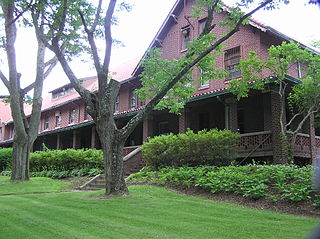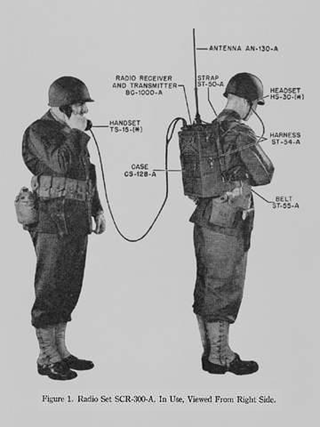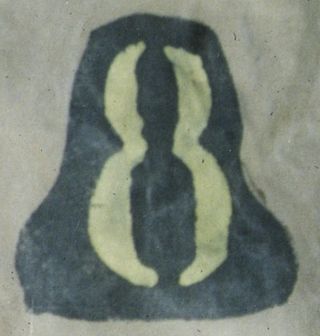
The SCR-270 was one of the first operational early-warning radars. It was the U.S. Army's primary long-distance radar throughout World War II and was deployed around the world. It is also known as the Pearl Harbor Radar, since it was an SCR-270 set that detected the incoming raid about 45 minutes before the 7 December 1941, attack on Pearl Harbor commenced.

The United States Army Signal Corps (USASC) is a branch of the United States Army that creates and manages communications and information systems for the command and control of combined arms forces. It was established in 1860, the brainchild of Major Albert J. Myer, and had an important role in the American Civil War. Over its history, it had the initial responsibility for portfolios and new technologies that were eventually transferred to other U.S. government entities. Such responsibilities included military intelligence, weather forecasting, and aviation.

Camp Evans Historic District is an area of the Camp Evans Formerly Used Defense Site in Wall Township, New Jersey. The site of the military installation is noted for a 1914 transatlantic radio receiver and various World War II/Cold War laboratories of the United States Army. It was designated a National Historic Landmark District in 2012, in recognition of the site's long role in the development of modern civilian and military electronic communications.

The SCR-268 was the United States Army's first radar system. Introduced in 1940, it was developed to provide accurate aiming information for antiaircraft artillery and was also used for gun laying systems and directing searchlights against aircraft. The radar was widely utilized by both Army and Marine Corps air defense and early warning units during World War II. By the end of World War II the system was already considered out of date, having been replaced by the much smaller and more accurate SCR-584 microwave-based system.

The SCR-584 was an automatic-tracking microwave radar developed by the MIT Radiation Laboratory during World War II. It was one of the most advanced ground-based radars of its era, and became one of the primary gun laying radars used worldwide well into the 1950s. A trailer-mounted mobile version was the SCR-784.

The SCR-284 was a World War II era combination transmitter and receiver used in vehicles or fixed ground stations.
Paul E. Watson was a pioneer researcher in the development of radar. Born in Bangor, Maine, Watson was a civilian engineer employed by the U.S. Army Signal Corps from the late 1920s. In 1936, he was named Chief Engineer of a Signal Corps research group at Camp Evans in Fort Monmouth, New Jersey tasked with developing a workable long-range radar for coast defense. By 1937 Watson's team had developed a proto-type "Search Light Control Radar" (SCR-270) apparatus and successfully demonstrated it to the Secretary of War at Fort Monmouth. Watson's team then became the "Radio Position Finding Section", and worked with the Westinghouse Corporation over the following year to develop an Early Warning Radar, which was successfully deployed at Highlands, New Jersey in August, 1938, and was capable of detecting incoming bombers at a range of 78 miles. A second system was deployed in Meriden, Connecticut in June, 1939, with an operational range of 138 miles.

Signal Corps Radios were U.S. Army military communications components that comprised "sets". Under the Army Nomenclature System, the abbreviation SCR initially designated "Set, Complete Radio", but was later misinterpreted as "Signal Corps Radio."

The SCR-299 was a U.S. Signal Corps mobile military communications unit used during World War II.

The SCR-300, designated AN/VRC-3 under the Joint Electronics Type Designation System, was a portable radio transceiver used by US Signal Corps in World War II. This backpack-mounted unit was the first radio to be nicknamed a "walkie talkie".

The SCR-277 was a mobile, trailer mounted radio range set for radio guidance of aircraft. It was standardized by the U.S. Army in June 1941.
The AN/MRN-1 was an instrument approach localizer used by the Army Air Force during and after World War II. It was standardized on 3 July 1942. It replaced the SCR-241, and was a component of SCS-51.
The AN/MRN-3 was a marker beacon set used by the Army Air Force during and after World War II, it was standardized 23 October 1943, and replaced SCR-241.
Harold Adelbert Zahl was an American physicist who had a 35-year career with the U.S. Army Signal Corps Laboratories, where he served as the director of research at Fort Monmouth and made major contributions to radar development. He invented the GA-4 Transmitter-Receiver Tube and the VT-158, which became known as the Zahl tube.
John William Marchetti was a radar pioneer who had an outstanding career combining government and industrial activities. He was born of immigrant parents in Boston, Massachusetts, and entered Columbia College and Columbia School of Engineering and Applied Science in 1925. In a six-year program combining liberal arts and engineering, he earned both A.B. and B.S. degrees, followed by the graduate E.E. degree in 1931. He was employed by New York Edison as a power engineer for several years, during which time he also participated in the U.S. Naval Reserve as an Ensign.

The SCR-245 Radio was a mobile MF/HF Signal Corps Radio used by the U.S. Army before and during World War II, for short range ground communications, It was one of the first crystal controlled sets used by the Army.

Air Warning Squadron 8 (AWS-8) was a United States Marine Corps aviation command and control unit that provided aerial surveillance and early warning of enemy aircraft during World War II. The squadron was commissioned on 3 March 1944 and was one of five Marine Air Warning Squadrons that provided land based radar coverage during the Battle of Okinawa in 1945. AWS-8, utilizing the callsign "Arsenic," remained on Okinawa as part of the garrison force following the Surrender of Japan. The squadron departed Okinawa for the United States in February 1946 and was quickly decommissioned upon its arrival in California. To date, no other Marine Corps squadron has carried the lineage and honors of AWS-8 to include Marine Air Control Squadron 8 (MACS-8).

The VT-158, also known as the Zahl tube, was a vacuum tube invented by American physicist Harold A. Zahl in the 1930s and used during World War II and the Korean War. It allowed the radar technology at the time to detect low-flying planes by generating enough power to produce ultrahigh frequency energy.

AMES Type 6, also known as the Light Warning Set or L/W, was a portable early warning radar developed by the Air Ministry Experimental Station (AMES) for use by the Royal Air Force (RAF) in the field. Units in British Army service were officially known as Radar, Anti-Aircraft, Number 4, or AA. No. 4 for short, although this name was rarely used in practice. The system was also built in Canada for use by the US Army, who referred to them as SCR-602-A.














